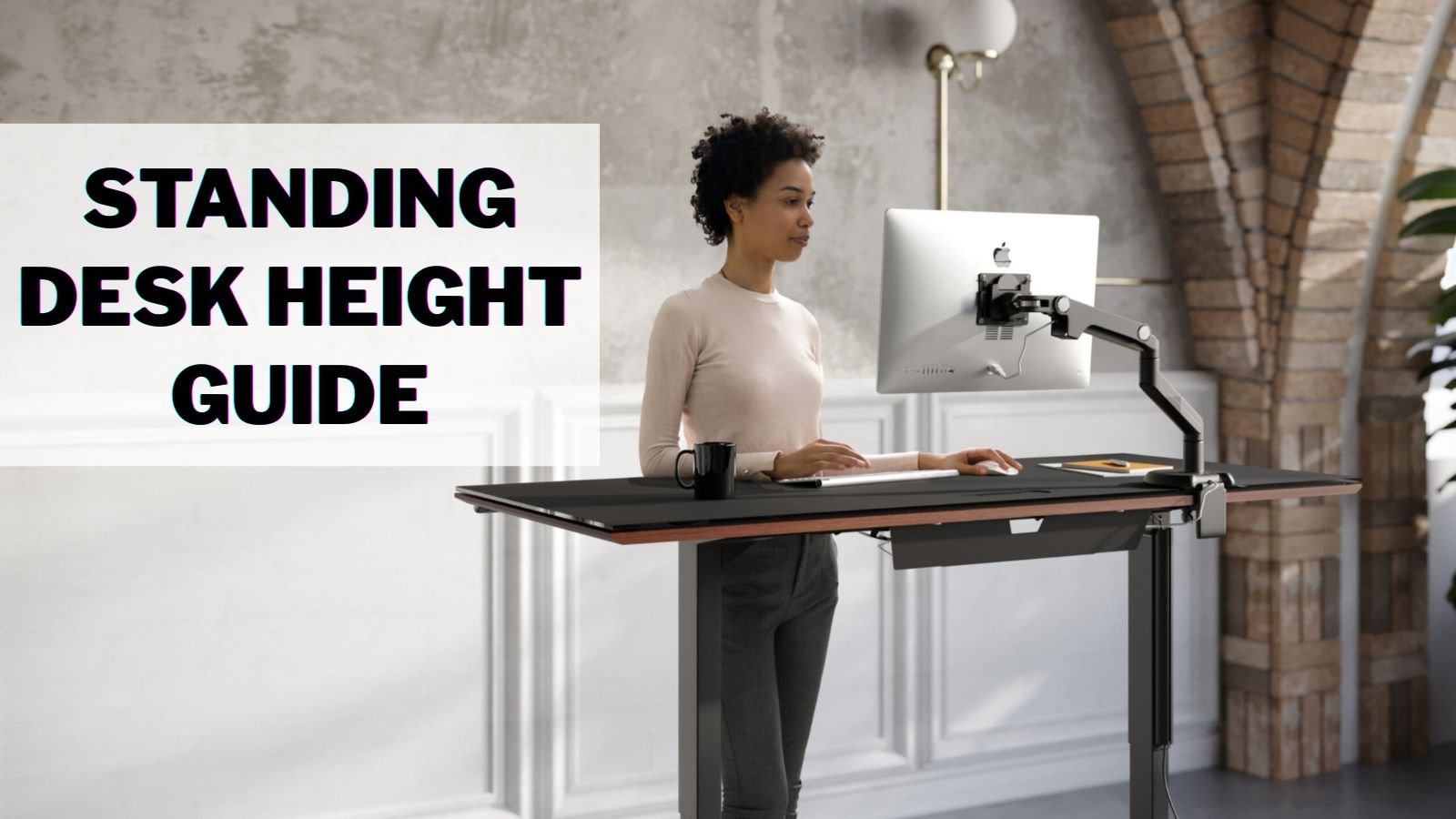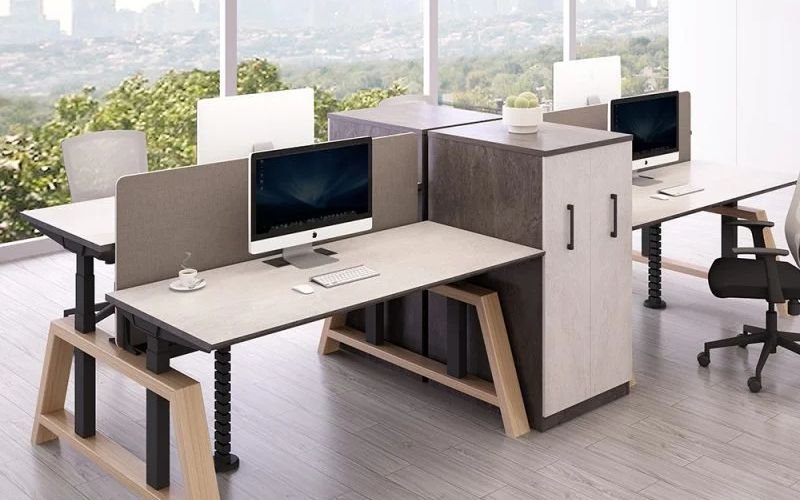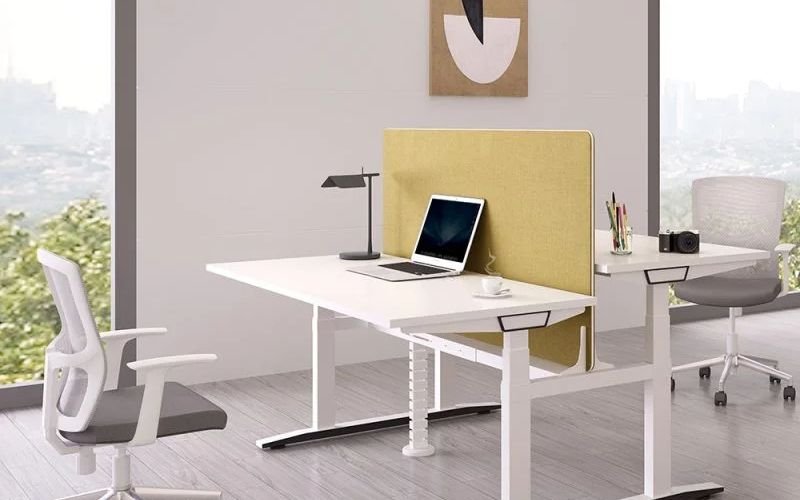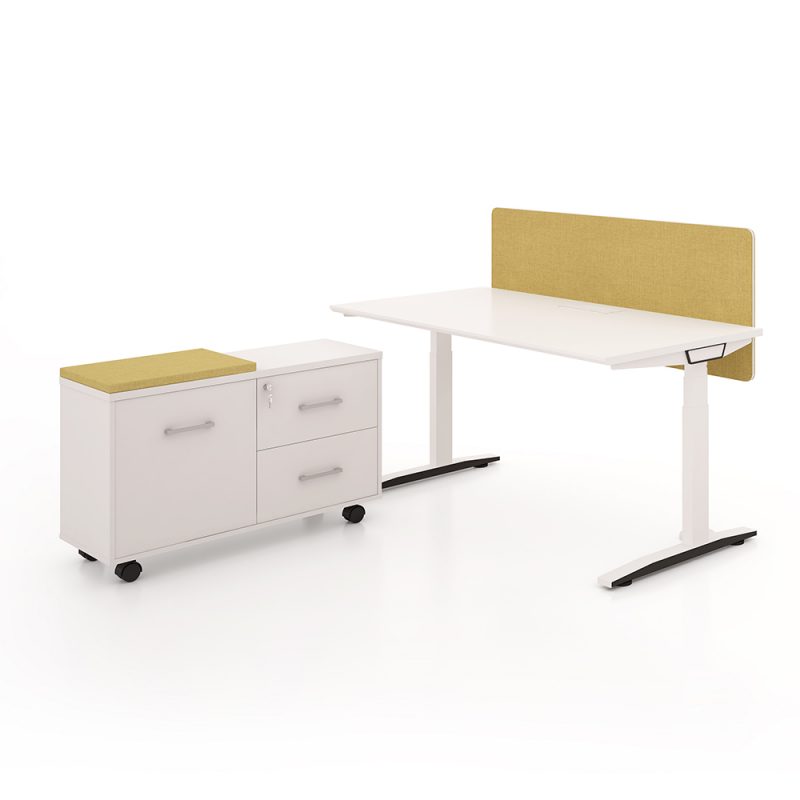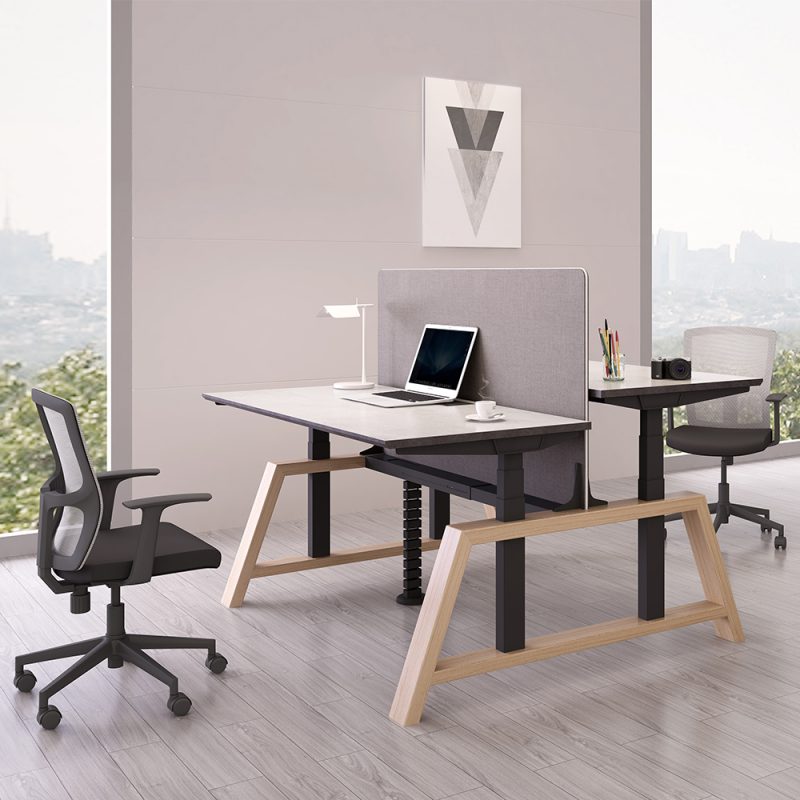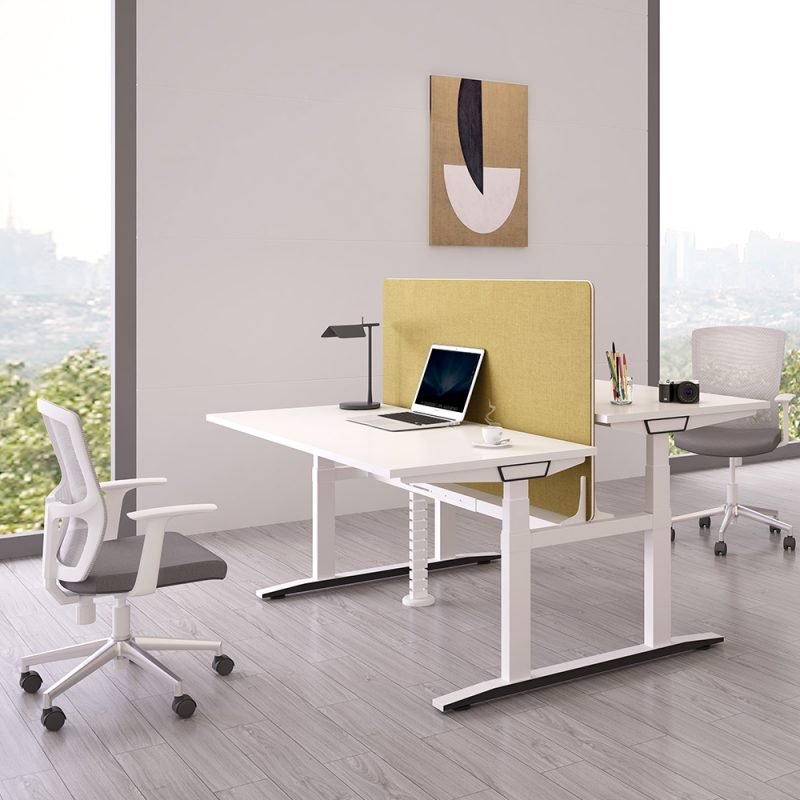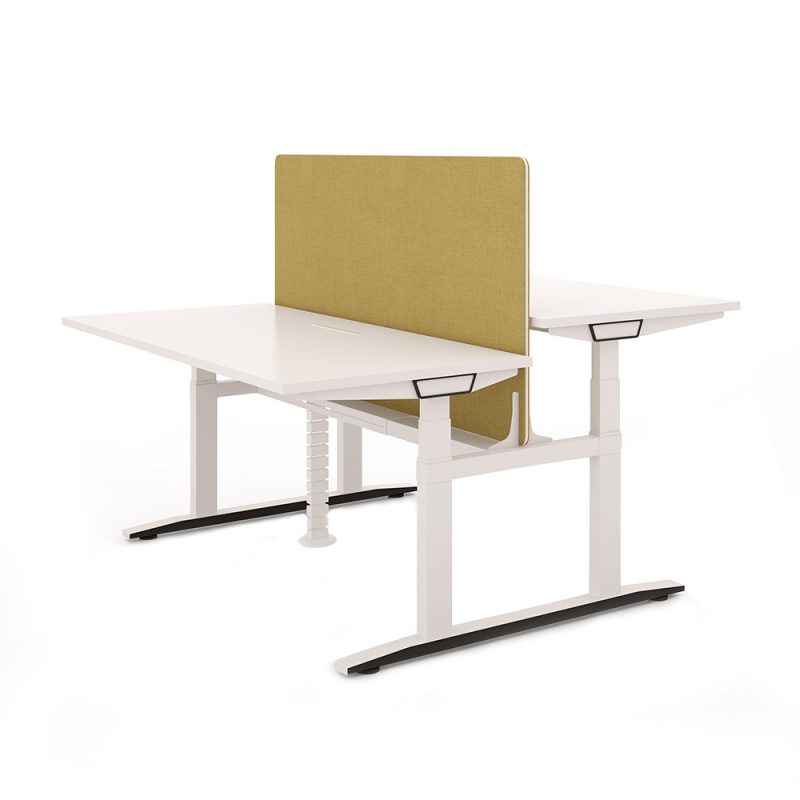When choosing a standing desk, height is often the key factor determining comfort and health. An incorrect desk height can increase cervical spine pressure, cause wrist fatigue, and affect concentration and work efficiency.
As a professional office ergonomics team, Meet&Co combines authoritative research and practical usage experience to provide you with a scientific method for calculating standing desk height, an ideal height chart corresponding to different heights, and answers to the most common questions encountered when adjusting desk height.
Whether you are a remote worker or an office employee, this guide will help you achieve standing work safely and comfortably.
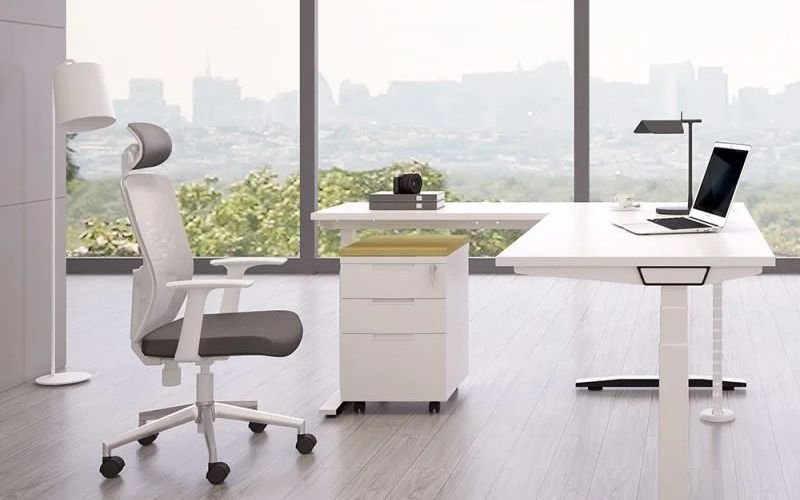
Why Is Standing Desk Height So Important?
An inappropriate standing desk height can affect your sitting posture, put immense pressure on your shoulders and neck, and, in more serious cases, even lead to lumbar disc herniation.
When the desk is too high, you may unconsciously shrug your shoulders or raise your arms to operate the keyboard and mouse, thereby increasing tension and fatigue in the shoulders and neck. Conversely, when the desk is too low, you will habitually hunch over, causing lower back pain.
Therefore, maintaining an appropriate desk height is crucial for improving posture, comfort, and work efficiency, while also preventing discomfort.
What Is The Standard Standing Desk Height?
While there is no “typical” or “standard” standing desk height that suits everyone, there are some internationally recognized references.
Generally, the standard height of most office desks is 28–30 inches (71–76 cm), but this is only suitable for people around 6 feet (approximately 1.8 meters) tall. People shorter or taller than this range will feel uncomfortable.
Therefore, we advocate adjusting the standing desk height based on individual height—the taller you are, the higher the desk surface should be.
📖 You also like: What is the Ideal Standard Desk Height for You? 2025 Guide
How To Determine The Ideal Standing Desk Height (Step-By-Step Guide)
Step 1: Measure Your Elbow Height
1. Put on your usual work shoes
Shoe sole thickness affects your actual height. If you usually wear sneakers or thick-soled shoes, you must wear them during measurement.
2. Maintain a natural standing posture
Stand straight with your feet shoulder-width apart and your body relaxed—do not deliberately puff out your chest or suck in your stomach.
3. Keep your arms bent at 90°
Let your arms hang naturally, then bend your elbows approximately 90°, with your palms facing inward or slightly toward your body.
4. Measuring elbow height
Use a tape measure to measure the vertical height from the floor to the bend of the elbow, recording to the nearest millimeter or decimal centimeter.
5. Determine the base height of the tabletop
Desk height ≈ elbow height ± 2–3 cm (generally no more than ±5 cm).
- If you primarily type, choose a desk that’s close to elbow height or slightly lower by 1–2 cm.
If you frequently write or draw, choose a desk that’s slightly higher by 1–2 cm.
6. Practical testing and fine-tuning
Place your keyboard on a desk and stand at it while typing for 5–10 minutes. Check:
- Are your wrists neutral (not tilted or pressed down)?
- Are your shoulders relaxed (not hunched or slumped)?
If it’s uncomfortable, adjust it up or down by 1–2 cm.
Step 2: Adjust Monitor Height
1. The monitor should be at eye level or slightly lower by 2-3cm
This prevents frequent lifting and lowering of the head, which can cause neck pain.
2. Multi-monitor users
If you have two monitors side by side, it’s recommended to position the one you use directly in front of you and the other slightly to the side.
If you have three or more monitors, it’s best to place the primary monitor directly in front of you, with the secondary monitors slightly curved around the primary.
3. Laptop users
Do not use a laptop directly on a table, as the screen will be too low.
It’s recommended to use a stand to raise the laptop to the appropriate height and connect an external keyboard and mouse before use.
Step 3: Fine-Tune And Trial
1. Consider shoe variations
Different shoe styles have different sole thicknesses. For example, the thickness of sneakers and leather shoes can differ by 1-2 cm. Therefore, it’s best to fine-tune your desk height based on the shoes you wear daily.
2. 2-3 days of adjustment
Once you’ve found the right desk height, spend 2-3 days adjusting to it and observe if you experience any discomfort in your wrists, shoulders, and neck.
3. Dynamic adjustment
One of the advantages of a standing desk is its adjustability. Depending on your workload (typing, writing, video conferencing), you can adjust it up or down by 1–2 cm.
4. Lock in the height
After the adjustment period is complete and you experience no discomfort, you can set this height as a permanent benchmark.
Standing Desk Height Calculator
Find your ideal ergonomic standing desk height with our easy-to-use Standing Desk Height Calculator. This tool helps you adjust your standing desk to the correct height for better posture, comfort, and productivity.
Standing Desk Height Chart
The ideal desk height varies with different heights. The following reference chart helps you quickly find the suitable standing desk height for yourself, and you can fine-tune it according to personal habits.
| Height | Desk Height (cm) | Desk Height (inch) | Desk Height (mm) |
|---|---|---|---|
| 160 cm (5’3″) | 104 cm | 40.9 in | 1040 mm |
| 165 cm (5’5″) | 107 cm | 42.1 in | 1070 mm |
| 170 cm (5’7″) | 111 cm | 43.7 in | 1110 mm |
| 175 cm (5’9″) | 114 cm | 44.9 in | 1140 mm |
| 180 cm (5’11”) | 118 cm | 46.5 in | 1180 mm |
| 185 cm (6’1″) | 120 cm | 47.2 in | 1200 mm |
| 190 cm (6’3″) | 124 cm | 48.8 in | 1240 mm |
| 195 cm (6’5″) | 127 cm | 50.0 in | 1270 mm |
| 200 cm (6’7″) | 131 cm | 51.6 in | 1310 mm |
Ideal VS. Optimal Standing Desk Height
Ideal Height: Based on ergonomics
Ergonomics research indicates that the ideal height for a standing desk is primarily determined by height and the natural bend angle of the arms.
It’s generally recommended that when standing, your elbows bend at a 90–100° angle, your forearms resting naturally horizontally on the desk, and your shoulders relaxed.
- Ergonomics formula reference: Desk ≈ height × 0.62–0.65
- For example, for a person 170cm tall, the ideal desk height is approximately 105–110cm.
- The monitor height also needs to be adjusted accordingly: the top of the screen should be 2–3cm below eye level to avoid slouching or tilting your head.
This calculation provides a scientifically sound guideline for most people, ensuring minimal shoulder, neck, and wrist fatigue during extended periods of standing work.
Optimal Height: Fine-tune based on usage scenarios
While ergonomics formulas provide a baseline, the optimal height varies from person to person and requires fine-tuning based on different usage scenarios and work habits.
| Usage Scenario | Recommended Fine-Tuning | Reason |
|---|---|---|
| Typing | = Ideal height or -1~2 cm | Slightly lowering the desk allows the wrists to hang naturally, reducing suspended pressure and preventing fatigue. |
| Writing / Handwritten Notes | -2~3 cm | Handwriting requires more downward pressure; a slightly lower desk reduces tension from raised shoulders. |
| Coding | = Ideal height or +1 cm | Coding usually involves long hours of keyboard input + screen focus; raising by 1 cm helps keep wrists straight and reduces carpal tunnel pressure. |
| Drawing / Digital Art | -3~5 cm | Arm flexibility is needed for drawing; lowering the desk allows forearms to tilt naturally, improving flexibility and comfort. |
| Video Conferences / Reading | +2 cm | Keyboard use is not the main focus; more time is spent looking at the screen; a slightly higher desk helps keep the spine straight and avoids lowering the head. |
| Multitasking (Common Office Work) | = Ideal height (as baseline) | Suitable for most daily office work; no frequent height switching is required. |
Therefore, the “ideal height” is more like a scientific starting point, while the “optimal height” is the final adjustment based on personal needs, work methods, and equipment configuration.
Only by finding a balance between the two can you truly leverage the health and efficiency benefits of a standing desk.
How To Set Desk Height?
Electric Height-Adjustable Desks
Modern electric height-adjustable desks are usually equipped with digital panels or button controls. Users can quickly adjust the desk height using the up and down buttons.
Some high-end models even offer cm-level precise adjustment, which better meets ergonomic needs.
For example:
If you’re looking for the best electric height-adjustable desks of 2025, this article is definitely worth a look – 10 Best Electric Sit-Stand Desks for 2025
Hand-Cranked / Fixed-Height Desks
Hand-cranked or fixed-height desks have different adjustment methods: hand-cranked desks are adjusted via a crank, while fixed-height desks require setting the ideal height during assembly.
Regardless of the type, the core goal is to ensure the elbows are naturally bent at approximately 90° and the shoulders are relaxed.
How to Save Height Presets (For Shared Office Spaces)
In shared office spaces, frequent manual adjustments can reduce efficiency. The “height memory function” of electric height-adjustable lifting desks solves this problem perfectly:
Setting method:
- Adjust the desk to the ideal height.
- Press the “memory button” and hold down the number (e.g., M1, M2) until a beep sounds or the screen prompts.
- Next time, you only need to press one button to return to the saved height.
In shared work scenarios, each user can save their own height settings, eliminating the need for repeated adjustments and greatly improving efficiency.
Standing Desk Height Mistakes (Practical Experience From Reddit)
Case 1
User Experience Sharing: “When I first started using a fixed-height desk, I always felt tense in my shoulders, and standing for long periods of time was incredibly tiring. Later, I realized it was because I hadn’t considered the height of my shoes. My flat shoes were 2–3 cm lower than my usual sneakers, causing my shoulders to lift.”
Mistake: Estimating desk height based solely on height, ignoring factors like shoes and the softness of the floor.
Suggestion: When measuring and setting desk height, use elbow height as the final guide. It’s best to wear the shoes you normally wear at work and ensure your shoulders and arms are naturally relaxed.
Case 2
User Experience Sharing: “My monitor is too low, causing neck pain. I saw on Reddit that everyone recommended buying an adjustable stand. With the stand, I can raise the screen slightly below eye level, which makes my neck much more comfortable.”
Mistake: Ignoring the monitor’s position. The screen is either too low or too high, causing the neck to flex forward or backward.
Suggestion: The top of the screen should be slightly below eye level, directly in your primary line of sight. If necessary, use a monitor stand or adjustable base to ensure a natural neck position.
Case 3
User Experience Sharing: “I adjusted my desk height based solely on my height, ignoring my elbow angle. As a result, my wrists often ached and became numb after typing for extended periods.”
Mistake: Estimating desk height based solely on height, while ignoring the natural elbow bend angle, resulted in an inappropriate keyboard height.
Suggestion: Always use elbow height as the final estimate, keeping your elbow bent at approximately 90°–100° and your forearm naturally horizontal.
Case 4
User Experience Sharing: “I thought standing for longer periods of time was better, but I ended up with lower limb aches and swollen ankles. Later, I learned that prolonged inactivity can also lead to fatigue.”
Mistake: Standing still for extended periods of time, ignoring the importance of movement and alternating between sitting and standing.
Suggestion: Adopting a standing-sitting work cycle, such as the 20-8-2 principle (20 minutes standing, 8 minutes sitting, 2 minutes of movement), or taking short walks or stretching breaks every 30–60 minutes to relieve pressure on your lower limbs.
Summary & Next Steps
The optimal standing desk height is determined by a comfortable position with your elbows bent at 90° and at eye level.
You can consult an ergonomic height chart or calculator before making fine adjustments of ±1–2cm.
Electric height-adjustable desks offer one-touch adjustment, making them suitable for shared use and sit-stand situations. Desk height can be dynamically optimized for long-term comfort.
In short, the optimal standing desk height is elbow height ±1–2cm. To learn more, visit the Meet&Co website to view our electric height-adjustable desks.
FAQs About Standing Desk Height
The optimal height is typically when your elbows are bent about 90 degrees, with your forearms flat on the surface. The top of the monitor should be slightly below eye level, allowing your shoulders to relax and your wrists to avoid tension.
The 20 8 2 rule means: standing for 20 minutes, sitting for 8 minutes, and moving for 2 minutes, cycled through. This helps reduce fatigue and lower extremity discomfort.
It depends on your height. If you’re around 170-180 cm tall, 36 inches (91 cm) may be too high, causing you to raise your shoulders or strain your wrists, requiring minor adjustments.
It also depends on your height. For most adults, 27 inches (68 cm) is generally too low. When using a desk, your elbows may be bent below 90 degrees, causing your shoulders to slump forward, requiring either a higher angle or an adjustable desk.

